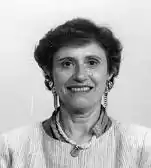Magda Ericson
Magda Galula Ericson (born c. 1929[1][2]) is a French-Tunisian physicist.
Magda Galula Ericson | |
|---|---|
 Portrait of Magda Ericson, CERN, Department of Theoretical Physics | |
| Born | December 18, 1929 (age 92) Tunis, Tunisia |
| Alma mater | Sorbonne |
| Known for | Ericson-Ericson Lorentz-Lorenz correction |
| Spouse(s) | Torleif Ericson |
| Awards | Palmes Académiques 1978 Humboldt Prize 1992 Knight of the Legion of Honour 2015 Fulbright scholarship 1960 |
| Scientific career | |
| Fields | Condensed matter physics Particle physics Nuclear physics |
| Institutions | Massachusetts Institute of Technology (MIT) Centre national de la recherche scientifique (CNRS) University of Lyon European Organization for Nuclear Research (CERN) |
| Thesis | Étude des fluctuations d'aimantation dans le fer au voisinage de la température de Curie par diffusion des neutrons |
Contributions
Magda Ericson's thesis on the temperature dependence of slow neutron scattering on iron was an important pioneering experimental study of critical phenomena near the Curie point.[3] Ericson is also known for her theoretical contributions to nuclear pion physics, which is a subfield of nuclear physics. She discovered the Ericson-Ericson Lorentz-Lorenz (EELL) effect of the pion-nuclear optical model within electroweak interactions,[4] alongside her husband, Torleif Ericson, a nuclear physicist from Sweden.[3][5] She has also been one of the leading researchers on the interpretation of the EMC effect.[6][7] Magda Ericson's contributions have been largely responsible for the development of nuclear pion physics as a subfield of nuclear physics and a large number of papers are based on her work.[3] Ericson continues her research to this day, although her husband has retired.[8]
Education and life
Magda received her PhD in experimental physics at the Sorbonne in 1958, working for the French National Centre for Scientific Research (CNRS).[9][8][10] In 1959 she received a Fulbright scholarship to MIT. She has been a visiting CERN researcher since 1965.[11]
Her cousin David Galula was a prominent military theorist.[12]
Awards and honors
 Knight of the Legion of Honour (2015)[13]
Knight of the Legion of Honour (2015)[13]- Humboldt Prize (1992)
- Palmes Académiques (1978)
- Fulbright scholarship (1960)
References
- "Galula-Ericson, Magda (1929- )". VIAF.
- "Marquis Biographies Online". search.marquiswhoswho.com. Retrieved 2015-04-17.
- "Magda Galula Ericson". CWP at UCLA. April 30, 1997. Retrieved March 8, 2015.
- Ericson, Magda; Ericson, Torleif (February 18, 1966). "Optical properties of low-energy pions in nuclei" (PDF). Annals of Physics. 36 (3): 323–362. Bibcode:1966AnPhy..36..323E. doi:10.1016/0003-4916(66)90302-2.
- Krige, J. (1996). "Physics in the CERN Theory Division: CERN, the centre of Europe". History of CERN, III. Elsevier. p. 306. ISBN 978-0-08-053403-9.
- Ericson, Magda (1986). The EMC effect and the swelling of nucleons in nuclei. Weak and Electromagnetic Interactions in Nuclei. pp. 382–392. doi:10.1007/978-3-642-71689-8_80. ISBN 978-3-642-71691-1.
- Ericson, Magda (1986). "Electromagnetic Interactions in Nuclei". Pion Number and the EMC Effect. New Vistas in Nuclear Dynamics. NATO ASI Series. Vol. 139. pp. 163–189. doi:10.1007/978-1-4684-5179-5_5. ISBN 978-1-4684-5181-8.
- "Faces and places: CERN lays on birthday treat for the Ericsons". CERN Courier. 50 (10): 41. December 2010.
- M., Ericson-Galula (1958). "Study by neutron diffusion of magnetic fluctuations in iron in the curie temperature region" (in French).
{{cite journal}}: Cite journal requires|journal=(help) - Brochard-wyart, Francoise; Prost, Jacques; Bok, Julien (2009). P. G. De Gennes' impact on science - Volume I: Solid state and liquid crystals. World Scientific. pp. 2–3. ISBN 978-981-4467-75-9.
- Seghal, Rashme. "Discovering the universe, one particle at a time". Rediff. Retrieved 2015-10-01.
- Marlow, Ann (August 2010). David Galula: His Life and Intellectual Context (PDF). Strategic Studies Institute. p. 21. Retrieved 2015-10-01.
- "Legifrance".
External links
- Magda Ericson's publication history on INSPIRE-HEP
- The Ericson-Ericson Lorentz-Lorenz correction[1]
- Celebration in Honor of Magda and Torleif Ericson's 80th Birthday, CERN, Zurich, September 17th, 2010.
- Brown, G.E. (1990). "The Ericson-Ericson Lorentz-Lorenz correction". Nuclear Physics A. 518 (1–2): 99–115. Bibcode:1990NuPhA.518...99B. doi:10.1016/0375-9474(90)90537-V.